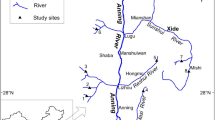Abstract
The occurrence and relative frequency of the 5 grey mullet species found in the Black Johnson Estuary, Sierra Leone, have been observed by sampling throughout the year. Examination of stomach contents and scales has also been made. Salinity within the estuary is maximum during the dry season and minimum at the height of the rains. The organic content of the sediment reaches a peak towards the end of the rains, but is low both at the end of the dry season and during the rains. Mullet tend to be most abundant as the rains are finishing and at the beginning of the dry season when the salinity is rising and the organic matter in the sediment is maximum. The mullet encountered in the estuary were Liza falcipinnis (Cuvier and Valenciennes), L. dumerilii hoefleri (Steindachner), Mugil cephalus ashanteensis Bleeker, M. curema Cuvier and Valenciennes and L. grandisquamis (Cuvier and Valenciennes). L. falcipinnis and L. dumerilii hoefleri penetrated furthest up the estuary and have been caught in freshwater some distance up rivers. All species feed principally on the detritus and algae in the estuarine sediment. There is some seasonal variation in the composition of the diet. Comparative data on the organic content of the estuarine sediment and the sand in the stomach of the mullet are given. A field experiment with L. falcipinnis suggests an assimilation efficiency of 52% for this species. Well-marked rings have been found upon the scales of four species, and their possible significance and use are discussed.
Similar content being viewed by others
Literature Cited
Arné, P.: Contribution a l'étude de la biologie des muges du Golfe de Gascogne. Rapp. P.-v. Réun. Commn int. Explor. scient. Mer Méditerr. 11, 77–113 (1938)
Bograd, L.: Occurrence of Mugil in the rivers of Israel. Bull. Res. Coun. Israel (Sect. B) 9, 169–190 (1961)
Buchanan, J.B. and J.M. Kain: Measurement of the physical and chemical environment. In: Methods for the study of marine benthos, pp 30–56. Ed. by N.A. Holme and A.D. McIntyre. Oxford: Blackwell 1971
Cadenat, J.: Note d'ichthyologie ouest-africain 8. Regime alimentaire sur les mullets de la côte occidental d'Afrique. Bull. Inst. fr. Afr. noire (sér. A) 16, 584–591 (1954)
Daget, J. et A. Iltis: Poissons de côte d'ivoir (eaux douces et sâumatres). Mém. Inst. fr. Afr. noire 74, 1–385 (1965)
Day, J.M.: The ecology of South African estuaries. Part 1: general considerations. Trans. R. Soc. S. Afr. 33, 53–91 (1951)
Délais, M.: Notes d'ichthyologie ouest-africaine 9: sur Liza dumerili Stein. et hoefleri Stein. Bull. Inst. fr. Afr. noire (sér. A) 16, 592–598 (1954)
Fagade, S.O. and C.I.O. Olaniyon: The food and feeding interrelationship of the fishes of Lagos Lagoon. J. Fish. Biol. 5, 205–227 (1973)
Fowler, H.W.: The marine fishes of West Africa. Bull. Am. Mus. nat. Hist. 70 (1), 1–605 (1936)
Gras, R.: Liste des poissons de Bas Dahomey saisant partie de la collection de laboratoir d'hydrobiologie du service des eaux, foret et chasses de Dahomey. Bull. Inst. fr. Afr. noire (sér. A) 23, 572–586 (1961)
Hickling, C.F.: A contribution to the natural history of the English grey mullets (Pisces, Mugilidae). J. mar. biol. Ass. U.K. 50, 609–633 (1970)
Irvine, F.R.: The fishes and fisheries of the Gold Coast, 352 pp. London: Crown Agents 1947
Moriarty, D.J.W.: The physiology of digestion of blue-green algae in the cichlid fish, Tilapia nilotica. J. Zool., Lond. 171, 25–39 (1973)
— and C.M. Moriarty: The assimilation of carbon from phytoplankton by two herbivorous fishes: Tilapia nilotica and Haplochromis nigripinnis. J. Zool., Lond. 171, 41–55 (1973)
Nikolsky, G.V.: Special ichthyology, 2nd ed. 538 pp. Moskva: Sovietskaya nauka 1954. [Transl. from Russ., Jerusalem.]
Thomson, J.M.: Growth and habits of the sea mullet, Mugil dobula Gunther, in Western Australia. Aust. J. mar. Freshwat. Res. 2, 193–225 (1951)
Trewavas, E. and S.E. Ingham: A key to the species of Mugilidae (Pisces) in the North Eastern Atlantic and Mediterranean, with explanatory notes. J. Zool., Lond. 167, 15–29 (1972)
Tucker, M.E.: The sedimentary environments of tropical african estuaries: Freetown Peninsula, Sierra Leone. Geologie Mijnb. 52, 203–215 (1973)
Williams, N.V.: The seasonal distribution of the teleost fish fauna in Lagos harbour, creek and lagoon, in relation to salt tolerance, Ph.D. thesis, University College of North Wales 1962
Wimpenny, R.: Observations on the size and growth of two Egyptian grey mullets, Mugil cephalus (Lin), the ‘bourie’ and M. capito Cuv., the ‘tobar’, Cairo, Ministry of Finance, Coast Guards and Fisheries Service: Government Press 1932
Winberg, G.G.: Rate of metabolism and food requirements of fishes, 257 pp. Minsk: Nauch. Trudý belorussk. gos. Univ. V.I. Lenina 1956. [Transl. Fish. Res. Bd Can., 201 pp. 1960]
Author information
Authors and Affiliations
Additional information
Communicated by J.H.S. Blaxter, Oban
Rights and permissions
About this article
Cite this article
Payne, A.I. The relative abundance and feeding habits of the grey mullet species occurring in an Estuary in Sierra Leone, West Africa. Marine Biology 35, 277–286 (1976). https://doi.org/10.1007/BF00396875
Accepted:
Issue Date:
DOI: https://doi.org/10.1007/BF00396875




